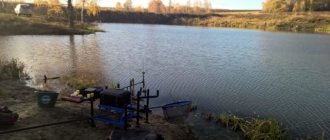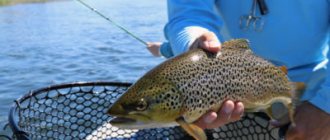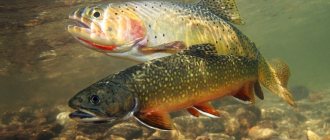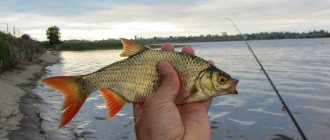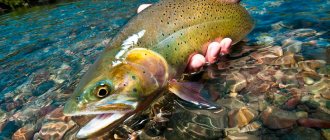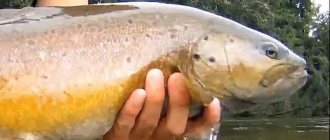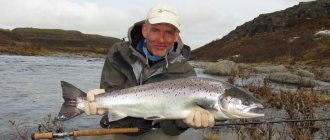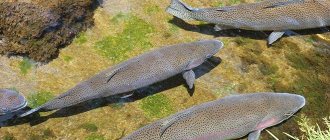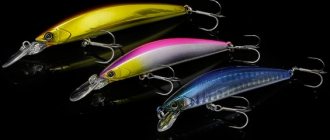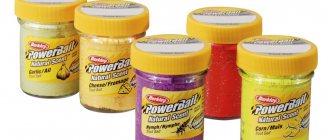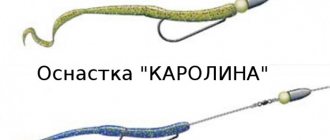Winter trout fishing rods have some specific equipment. With some luck, the trout can be pulled out using regular tackle with a bloodworm and a jig. However, if the result is important, and not just a pleasant weekend on the ice, it is better to approach this issue thoroughly. Winter trout fishing has become accessible to all anglers in the middle zone. If earlier for a spotted beauty you had to travel at least to the North-West (and better yet, to Karelia or the Kola region), now a countless number of paid ponds in the Middle Zone lure anglers to fish for trout.
Ice fishing for trout
Trout are active in winter and can be caught throughout the freeze-up period. If it is difficult to get to the treasured habitats of the wild population, then the rainbow trout of the fee-paying fishermen is it; almost every major city has its own pond. General features of winter fishing for this fish, search tactics and fishing techniques are discussed in a separate article:
In this publication, we’ll take a closer look at the winter trout fishing rods themselves, and look at the features of the equipment and the use of various baits. Ice fishing for spotted beauty is not limited to using only fishing rods. For more details, see the article about fishing gear for trout in winter.
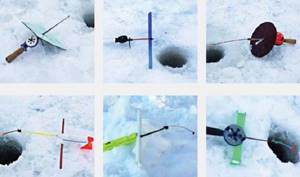
Trout winter fishing rods
A fishing rod for trout fishing in winter is an ordinary fishing rod with a reel, medium or large caliber. Regular winter fishing rods from the store will do. The secrets and nuances lie in the equipment itself and the correct use of bait. We are all accustomed to fishing in winter from the bottom or near it. To catch a spotted predator, you need to break this stereotype in yourself. Trout don't dig at the bottom.
She patrols the water area and eats food in the water column (while, of course, she can also take from the bottom, but this is an exception to the rule). In the standard version, the bait should be located 10-30 cm from the bottom or higher. In a thaw, it can even bite under a cut of ice. This feature is the main factor influencing the equipment.
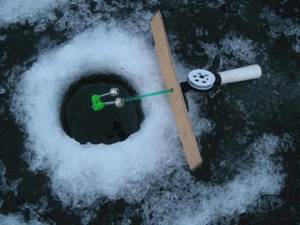
For winter fishing for trout, you need a high-quality line, and at the same time not too thick. This fish is not very smart, but in winter it is cautious and may simply not approach if something is bothering it. In addition, one frightened fish can scare away the entire school by escaping. Depending on the conditions, the diameter used is from 0.16 to 0.3 mm. You shouldn’t make the equipment too thin - a large and strong fish will simply tear it. In wild conditions, it is better to use thinner equipment - the water in such reservoirs is crystal clear. The fishing line for trout fishing in winter on a platform must be placed based on the size of the trophies present in the reservoir. Before we consider how to equip a winter fishing rod for trout, let’s touch on the issues of bait, since the choice of mounting used largely depends on the bait.
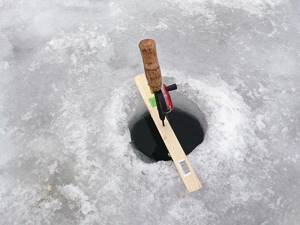
The ruler saved
Bait
The baits and baits used for trout in the winter on paid sites are the same as when fishing in wild reservoirs. The most popular ones are shrimp and trout paste.
Shrimps
Fishing for trout in winter with shrimp is a classic of the genre. Crustaceans are the natural food of this fish, and the smell of spotted shrimp is very attractive. To catch trout with shrimp in winter, crustaceans can be boiled (without salt and spices), but sometimes spotted trout respond better to raw ones. This is a matter of preference of fish in a particular body of water. You need to attach either the peeled meat of the shrimp neck or the entire crustacean to the hook. The hook point is left exposed or not hidden deeply (as with any other bait). Trout do not close their jaws tightly when grasping (like pike perch or pike perch), and can quickly abandon the tackle if they feel something is wrong. An open tip increases the likelihood of a successful hook.
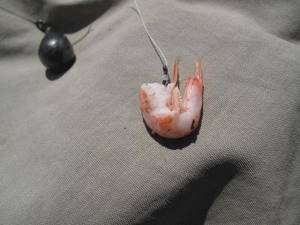
Squid meat
In addition, trout fishing is practiced in winter using squid. Squid is usually sold frozen. Before going fishing, it should be cut into strips no more than 4 cm long. When boiled, the squid stays on the hook better, however, the natural smell is weakened when cooked. To cook or not to cook – the fish in the pond will tell you.
Caviar
The Spotted fish is excellent at catching large red salmon eggs. However, this bait is expensive. In fishing stores you can find artificial red caviar, but it, of course, is not a rival to natural caviar in terms of catchability. The use of caviar requires care, as it does not stick well to the hook. It is better to place it on the thinnest barbless hooks so that the eggs do not burst or leak out. You can properly catch trout for caviar in winter using a slowly sinking rig (more on this later), using thin, neat hooks. Fishing for trout with caviar in winter on paid platforms is not advisable - there are many easier-to-use baits (the same shrimp or paste with the smell of caviar). But on wild rivers this bait is an irreplaceable thing during periods of capricious bite, especially after salmon spawning, when caviar is naturally present in the reservoir, and trout eat it.
Regular attachments
You can also use standard winter bait - bloodworms, maggots or worms. However, these baits are often bitten by small fish or fish accompanying trout in the pond. In addition, only small trout will most likely take such bait. They need to be planted in a bunch, at least the size of a cherry.
Lure
In some reservoirs, feeding has a beneficial effect on the bite in winter. The predator is attracted by the turbidity and smell of animal components - shrimp, caviar, etc. As bait, you can use leftovers from shrimp, special mixtures or trout feed (which, in fact, is what fish in ponds are fed). All of these can be used separately or mixed. The mass must be finely crushed so that it simply produces turbidity and does not saturate the fish. Otherwise, the attracted trout may begin to eat the bait, ignoring the bait on the fishing rod.
Trout paste
An excellent bait is a special trout paste that has the consistency of dough. Balls are molded from it (again, the size of a cherry) and placed on a hook. The main attraction factor is smell and color. Sparkles are usually added to the bright multi-colored mass, which additionally attracts fish. The paste consists of a protein mass, saturated with various aromas and animal marc - fish, caviar, shrimp, crustaceans, daphnia and cyclops. Cheese, caviar and shrimp flavors work best for trout.
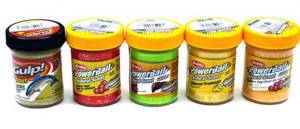
Berkeley pasta
The paste can be sinking or floating - and this is important to consider when using equipment. However, sinking pasta can be made to float by placing a ball of foam inside the lump. And vice versa - drown the mass, securing the pellet inside. Such options are “collective farms”, when you have to invent something already on a pond. It is better to have pre-set fishing rods in stock with equipment for both floating bait and sinking bait. Some fishermen make their own homemade cheese paste based on flour and eggs, adding cheese and other flavorings. However, now purchasing ready-made bait is not a problem. The most popular trout pastes are Berkley.
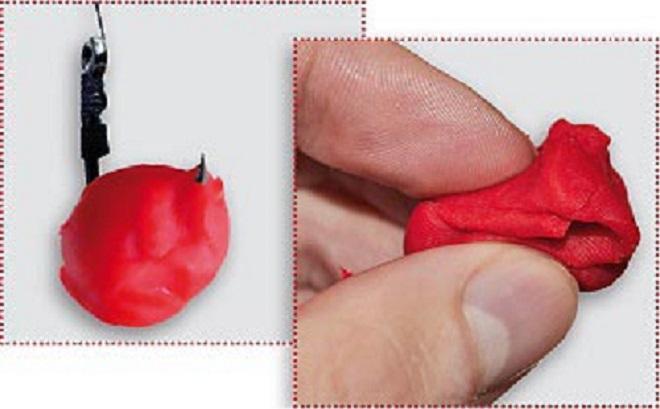
The paste cannot be stored in the refrigerator or freezer - when defrosted, it loses some of its properties and changes its smell. And this most directly affects the bite. Many fishermen have already stumbled upon such a “rake”.
The gear used for catching trout with pasta in winter is the same as with natural bait. The difference is in the hooks. For shrimp you need hooks with a long shank, for pasta - with a short, round one, with a sting curved inward. You can catch trout using pasta in winter both in paid ponds and in wild reservoirs. Next, we’ll look at gear for catching trout with pasta in winter (and all other baits).
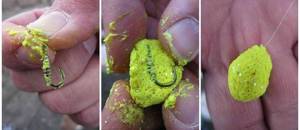
Fishing for trout in winter on paid platforms
Paid reservoirs for trout fishing have become not such a rare occurrence in our country. Here you can not only spend time while fishing, but also relax with the whole family, because in addition to the reservoir, on their territory there are comfortable houses with all the amenities in which you can spend several days. Another advantage is the fact that the owners of paid fishing grounds are interested in visiting fishermen being satisfied with their catch, and therefore willingly share information about the habits of the local predator and its places of dispersal (Figure 2).
Note: In addition, in paid reservoirs, trout grows faster than in wild ones, and with a size of 50-70 cm it can reach a weight of 1.5 kg.
Fishing for trout on a paid reservoir is very different from fishing in wild places. Here you don’t have to thoroughly know the topography of the pond, just take an interest in the habits and preferences of the fish. The choice of fishing location depends on how long ago the trout was released into the reservoir. If this happened several years ago, then the predator has already decided on her favorite places, and it will not be difficult to find her. Most often, a successful catch is possible in pits, channels, dumps, on coastal edges with a sharp difference in depth, in areas with uneven relief, as well as in flooded clearings, snags, stone boulders and other shelters. On the contrary, recently released trout actively move throughout the entire water area, and calculating the routes of its movement is quite problematic.

Figure 2. When you go fishing on a paysite, you are guaranteed to get a rich catch
Here you cannot do without knowledge of the bottom topography, or use the following tips to determine its features:
- Find out the location of the edges. To do this, you need to drill holes in the direction from the shore to depth. The difference in depth indicates that the edge has been found. It is at the very beginning of the decline in depth that fishing should be done.
- Ask the workers of the paid reservoir about the location of promising places that can please you with a catch.
- Listen to the recommendations of regular visitors to the paysite, who already know the terrain features and promising places well.
- Find your way around old holes or traces of them. There is a high probability that they will be quite catchy.
- You can start from the middle of the pond, since in winter trout often accumulate in the deepest place in the pond. By fishing all horizons and gradually moving towards the shore, you can achieve your goal and get an excellent catch.
- Remember the main rule when hunting for trout: the more holes in different parts of the reservoir and the wider the horizons that are fished, the larger and heavier the catch.
If you catch a fish, you must move on to the next hole, since the trout immediately moves away from the previous one, sensing danger.
Mounting options
Winter trout fishing rods are equipped in four main ways:
- Fishing rod for floating paste.
- Conventional equipment for fishing above the bottom.
- Slow immersion installation.
- Fishing rod for fishing in the current.
The fishing rod itself needs to be improved by placing a spacer on it (from a ruler, or better yet, two at once). The trout bite is sharp, without a spacer the fishing rod will simply go into the water. To do this, a hole is drilled in the middle of the ruler and the rod whip is inserted into it.
Fishing rod rig for floating paste
This type of rig for a winter trout fishing rod is the simplest option, consisting of a sliding sinker on a stopper and a hook at the end of the fishing line. The sinker must be sliding in order to use the stopper to regulate the length of the leash (and, thus, the height of the ascent of the floating nozzle). The same rod can be used with all other baits in those rare cases when trout take it from the bottom. The fishing rod can be equipped with either a float, which is completely recessed with a sinker, or a nod. The nod for trout has no special requirements - the main thing is that it does not bend completely in the working position (it still has a reserve of free movement). The bite is expressed by sinking the float or pulling the nod down.
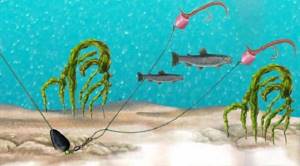
Floating bait, sinker on the bottom
Standard installation
To catch trout in winter using pasta with negative buoyancy (and all other baits), you need equipment that places the bait in the water column (usually about 20 cm from the bottom). When using a nod, the previous option is also suitable, the main thing is that the sinker is not too heavy and does not completely bend the nod. When using a float, its buoyancy along with the sinker and bait should be positive. The float should hold the tackle and not sink. But this is fraught with the risk of the float freezing into ice in severe frosts. A universal option is a nodding rod rig. Provided the weight of the sinker is selected and the elasticity of the nod, such a fishing rod can be used both from the bottom and in the water column. As already mentioned, the equipment for pasta is equipped with a hook with a short shank, and for shrimp - with a long shank.
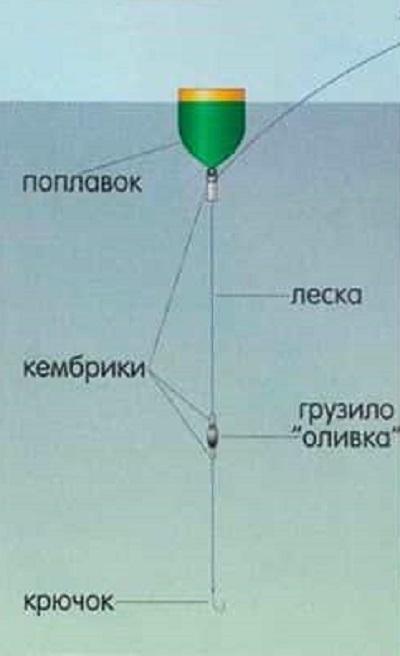
Fishing rod for deep water
Submersible equipment
Trout love naturally sinking lures. She cannot resist the smooth dive. And the fishing rod of an experienced trout fisherman is a finely tuned balance of the float and the weight of the load with the nozzle, when the bait slowly sinks to the bottom (for this, a reserve of fishing line is left on the ice). This is a tool for the most capricious trout. Catching trout with caviar in winter (and with other baits too) using this method can tempt the most capricious fish to bite.
For such installation, you need to very carefully select the weight of the load to the float, and use a certain weight of the bait. When the fishing rod is immersed in water, a bare hook should barely stay afloat, and when a bait is added to it, it should begin to slowly sink (a couple of centimeters per second). The fisherman is watching the hole at this time. The bite manifests itself in a violation of the uniform lowering of the float, its jerking down or to the side.
This is an active fishing method, it involves constant control of the gear. The fishing rod must be raised periodically, again causing the bait to sink. On paid sites, you don’t have to worry so much - the iris will bite on bait just hanging in the water. This method is a last resort for wild, capricious and cautious fish.
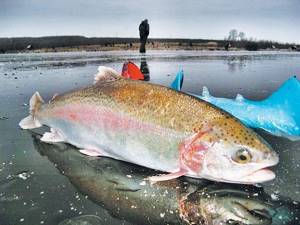
Trout rig for current
There is almost always no current on the pay zones, and this method is for rivers and wild trout. The equipment of the fishing rod consists of a blind weight at the end and a retractable leash. For active biting, you can use a special wire outlet (to prevent confusion with the main fishing line). By and large, in a strong current there is no need for a bend - the hook with the bait will be carried to the side anyway. And for cautious fish, any additional equipment components are superfluous.
It is better to make the fishing rod thin and neat, without additional metal parts and fittings. One swivel is enough (on which the leash is attached; the main line is passed into its second ring, limiting the position with stoppers). It is better to place the leash on the main line through a swivel with rubber stoppers at the top and bottom. This will allow you to change the fishing horizon without tying, setting the required distance from the bottom (and this is an important part of tactics, especially in wild reservoirs).
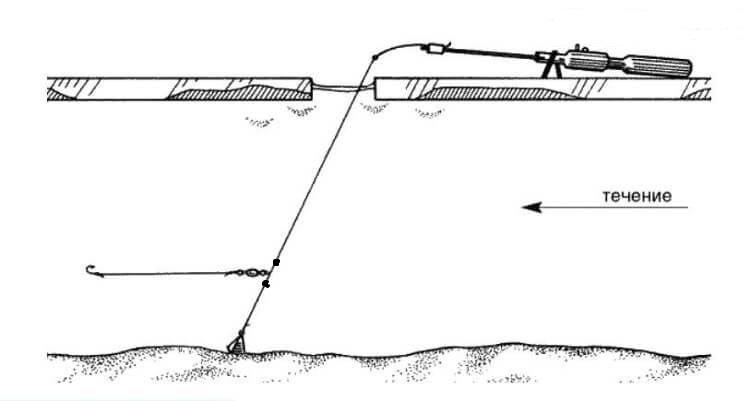
Setting for Current
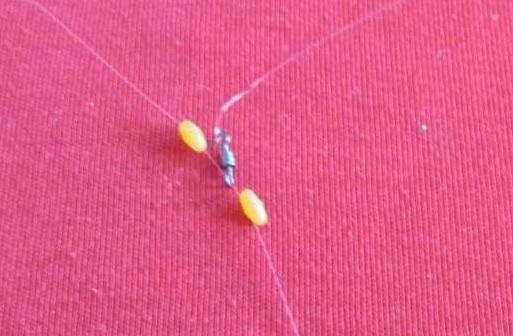
Attaching the leash to the main line via a swivel
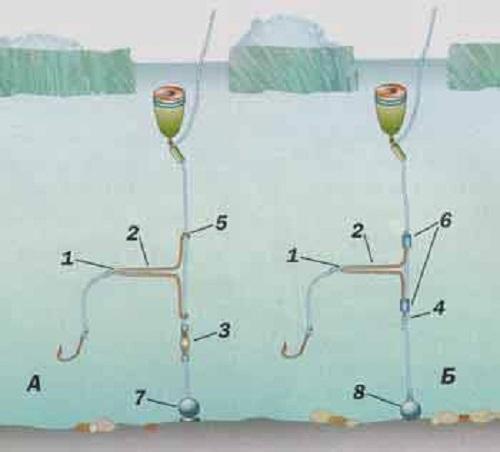
With wire guide
How to choose a trout spinning rod
Fast or parabolic spinning rods are suitable for trout fishing. In the first case, only the tip of the rod is flexible. Spinning is capable of making precise casts with light, extended baits, allowing you to instantly hook prey and carefully fish out resisting fish. However, fast action models are only suitable for fishing in small ponds and rivers. They cannot make long casts with whipping strokes and will be effective when the trout are actively biting.
In rods with a parabolic action, their entire part bends all the way to the handle. When casting, the blank works completely, and the bait flies far. Spinning rods instantly respond to bites, prevent fish from leaving, but do not load well with light spinners and wobblers. Such rods require a smooth swing with lures weighing 20 grams or more. They are suitable for fishing in spacious reservoirs, wide rivers with strong currents.
Using jigs
Trout jigs can be used in the installation of passively standing fishing rods, instead of a sinker with a hook. However, it is not known in advance whether the fish will suddenly refuse the jig and will only take it on a hook with bait. It is better to have a separate fishing rod with a jig and use it according to the situation. But catching trout with a jig in winter expands the fisherman’s efficiency. With a jig you can quickly fish a layer of water without waiting for a bite on the stand. And this can be used very well in search tactics. For example, you can search for fish with a jig, and when there’s a bite, place stands around. Trout is a schooling fish. One bite means that there is hardly one fish here.

The jigs themselves for trout in winter are large, weighing from 1-2 grams, with relatively large hooks and a long shank. It is better to put a shrimp on the hook, but with a normal bite, the trout will also take a game without a bait. The colors available are white, silver or black. Trout, like all salmon, are attracted to bright orange and pink shades. This is a matter of experimenting directly on a reservoir. The nozzle should be decorated with beads, fibers, or something small made of edible rubber should be attached.
With bait, the jig can simply hang in the desired fishing horizon. Naturally, you need to play without a nozzle. From time to time, it won’t hurt to play along on a standing fishing rod with bait. The main type of game is slow rises and falls with pauses at the top and bottom. The second option is to slowly lower the bait along the entire horizon. Trout does not like sudden jumps and amplitude jerks.
Subscribe to the channel:
My YouTube channel RYBAFAN on fishing:
We're OK
Selection of gear
Trout is an omnivorous fish, which gives you the opportunity to choose a variety of tackle and bait. They catch it from the ice in several ways:
1) on the girders;
2) on a nodding fishing rod;
3) on the float.
Each of them has its own advantages and disadvantages. The choice depends on the preferences of the angler, as well as on the characteristics of the reservoir and the activity of the fish.
Zherlitsy
Not everyone likes to fish with girders. This gear practically does not require the participation of the fisherman in the process and is aimed, first of all, at achieving results. Nevertheless, this method of fishing is quite popular and allows the fisherman to seriously count on catching large specimens.
Trout fishing in winter takes place using regular fishing rods designed for pike perch or pike perch. The only thing that may be required is replacement of equipment:
• The leash used for pike fishing is not needed for trout. The hook can be tied directly to the main line. If you use a leash, it should be made of fluorocarbon fishing line up to half a meter long and with a diameter of 0.20-0.24 mm.
• The line should not be too thick so as not to scare away sensitive fish. If the bulk of the fish in the pond weighs between 1.5-2 kg, then a monofilament line with a diameter of 0.25 mm is suitable, for larger fish - 0.28-0.30 mm.
• The hook must be perfectly sharp to pierce the trout's strong mouth. Size according to the international table – No. 4-6.
The rig uses a sliding weight, fixed with stoppers at a distance of up to 0.5 meters from the hook. This method guarantees self-hooking of the fish.
Fishing for trout in winter on girders will be successful if you have good knowledge of the reservoir. This gear is installed permanently on the hole and, if the angler does not know the exact location of the catch, he can easily be left without a catch.
Holes for vents are drilled at a distance of 5 meters. It depends on the fishing depth - the deeper it is, the farther the holes should be located from each other. The girders are checked every 40-60 minutes. If there are no bites for a long time, you should change the place.
Nodding fishing rod
Using a nodding fishing rod is suitable for all fans of active winter fishing. This method is also optimal if the trout’s parking areas are unknown and you need to additionally attract fish.
The selection of gear is as follows:
• The rod is durable and can handle large fish. The whip is hard, capable of breaking through strong jaws when hooked.
• A regular reel is suitable, with a diameter of about 5 cm, with a brake for releasing the line if necessary.
• The nod is short and matches the mass of the bait.
• Monofilament line, 0.20-0.25 mm thick. This line is enough to catch fish weighing up to 3 kg, while thicker monofilament will be too noticeable in the water.
• Jigs, balancers and spinners are used as bait.
This method is more popular than fishing with girders, due to the active participation of the angler and the ability to choose bait and method of play. At certain times, fishing with artificial baits can bring much better results than others. This is facilitated by the possibility of using additional baits from bloodworms, maggots, shrimp and others.
Float rod
Catching trout on a float is also quite interesting. If the bite is weak, you can provoke the fish by periodically moving the tackle.
The gear used is the same as for fishing with artificial bait, with some minor additions:
• The nod on the rod is not used, since the float is a bite alarm.
• The hook is attached to a leash up to 50 cm long and slightly less thick than the main line.
• An olive weight is used to secure the equipment.
• The float is matched to the weight of the equipment. The load should be such that the float antenna is at water level or slightly submerged.
When fishing with a float, you must ensure that the hole is not covered with ice and is not covered with snow and slush. This will block the float and make bites invisible.
For best results, you should raise the tackle by 30-50 centimeters every 1-2 minutes. The hook must be sharp to penetrate the trout's dense palate. After bringing the prey to the hole, it is better to pull out the fishing line with your hands, putting the rod aside.

